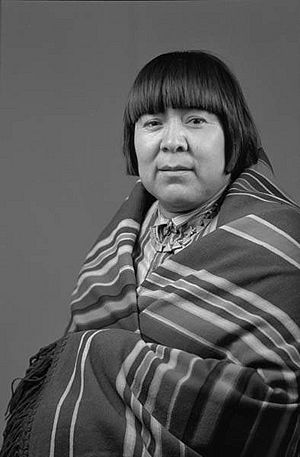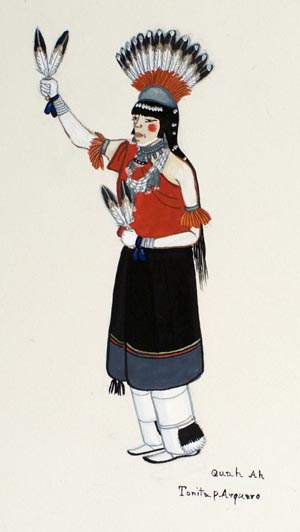Tonita Peña facts for kids
Quick facts for kids
Tonita Peña
|
|
|---|---|
| Quah Ah | |
 |
|
| Born | May 10, 1893 San Ildefonso Pueblo, New Mexico, U.S.
|
| Died | September 9, 1949 (aged 56) Santo Domingo Pueblo, New Mexico, U.S.
|
| Resting place | Cochiti Pueblo Cemetery, Cochiti Pueblo, Sandoval County, New Mexico |
| Known for | American Indian painting, Pueblo art |
| Style | pen and ink with watercolor on paper, murals |
| Movement | San Ildefonso Self-Taught Group |
| Spouse(s) | Juan Rosario Chavez (m. 1908–1910; death), Felipe Herrera (m. 1913–1920; death), Epitacio Arquero (m.1922–1949; death) |
| Patron(s) | Edgar Lee Hewett |
Tonita Peña (born May 10, 1893, in San Ildefonso – died September 9, 1949, in Santo Domingo Pueblo) was a famous Pueblo artist. Her birth name was Quah Ah, which means "white coral beads." She also used the names Tonita Vigil Peña and María Antonia Tonita Peña. Tonita Peña was known for her beautiful paintings made with pen and ink on paper, often with watercolor added. She was a very important and well-known Native American artist and art teacher in the 1920s and 1930s.
Contents
Tonita's Early Life and Learning
Tonita Peña was born in San Ildefonso Pueblo, New Mexico. Her parents were Ascensión Vigil Peña and Natividad Peña. When Tonita was 12 years old, her mother and younger sister sadly passed away from the flu.
Because her father could not care for her alone, Tonita moved to Cochití Pueblo. There, she was raised by her aunt, Martina Vigil Montoya, who was a famous potter in the Cochití Pueblo. Tonita also went to St. Catherine Indian School in Santa Fe.
Becoming a Famous Artist
Edgar Lee Hewett, a scientist who studied people and cultures, helped many artists from San Ildefonso, including Tonita Peña. He bought her paintings for the Museum of New Mexico. He also gave her good quality paint and paper to use.
By the late 1910s, Tonita started to become more famous. She sold more and more of her artwork to collectors and to the La Fonda Hotel. Her early paintings often showed traditional Pueblo life. She used an easel and Western painting materials, which helped her gain acceptance from other artists. By the time she was 25, her art was being shown in museums and galleries in Santa Fe and Albuquerque.
In the early 1920s, Tonita wrote letters to museum leaders. She was worried she was not being paid enough for her paintings. A local farmer had told her that her art was selling for much more than she was receiving.
Teaching Art and Breaking Barriers
In the 1930s, Tonita Peña taught art at the Santa Fe Indian School and the Albuquerque Indian School. She was the only woman painter in the San Ildefonso Self-Taught Group. This group included other well-known artists like Alfonso Roybal and Julian Martinez.
As children, these artists went to the San Ildefonso day school. This school was part of a government plan to make Native American children fit into mainstream American society.
In 1931, Tonita Peña showed her work at a special art show called the Exposition of Indian Tribal Arts in New York City. By 1932, the Whitney Museum in New York bought her painting Basket Dance for $225. This was a very high price for a Pueblo painting at that time. Most Native American paintings sold for only $2 to $25.
Tonita Peña's art was also part of a big art show called Stretching the Canvas: Eight Decades of Native Painting. This show was held at the National Museum of the American Indian in New York from 2019 to 2021.
Tonita's Impact and Legacy
Tonita Peña passed away on September 9, 1949. After her death, all of her remaining paintings and personal items were burned. This was done to follow Pueblo customs.
Tonita Peña's art helped change how people saw Native American culture. Her paintings showed the beauty and spiritual value of Native American traditions. She often focused on the important roles of women in daily life. She also helped change what people expected from women artists by painting instead of only making pottery, which was a traditional role for women. Her son, Joe Herrera, became an important modern American painter, greatly influenced by his mother.
Tonita Peña's artwork is now in many famous museums. These include the American Museum of Natural History in New York and the Heard Museum in Arizona. Her art continues to be shown in exhibitions even after her death. A crater on the planet Venus has even been named after Tonita Peña!
Challenging Traditions
Tonita Peña did not always follow the traditional roles for women in Native American art. She mostly created two-dimensional paintings on paper. At that time, pottery and ceramics were more common art forms for women.
She also pushed boundaries with what she painted. When she was active, only men were usually allowed to paint living people. Tonita painted people and ceremonies. She also chose to have others help raise some of her children so she could finish her education and focus on her art career. This was different from the traditions of her tribe and American society at the time.
During her life, the U.S. government tried to make Native Americans adopt American culture. Tonita Peña's art became a way to resist these efforts. Her paintings showed how important ceremonial dances were for the survival of Pueblo culture.
Facing Criticism
Some people, including members of her own tribe, criticized Tonita Peña's art. They believed that her paintings of sacred rituals were not appropriate to share outside the tribe. However, her husband, Epitacio Arquero, who was a leader in the Cochiti Pueblo, defended her. He said her paintings only showed things that outsiders could already see. After this discussion, Tonita's work began to focus on Pueblo culture and traditions that were not sacred or private.
Tonita's Family Life
Tonita Peña was married three times and had six children. Her first marriage was in 1908 when she was 15. This marriage was arranged by the village elders to Juan Rosario Chavez. He passed away in 1912. She had two children with him. After he died, she temporarily left her children with her aunt, Martina Montoya, so she could finish high school.
In 1913, Tonita had a second arranged marriage to Felipe Herrera. He died in a mining accident in 1920. Her son with Felipe, Joe Hilario Herrera, also became a famous painter.
Her last marriage was in 1922 to Epitacio Arquero. He was a politician who held important tribal positions at the Cochiti Pueblo. They had three children together.
See also



